CAITLIN MCGONNIGAL JUNE 25, 2019
In recent years, the threat of wildfires has increased in the United States due to the impact of climate change, especially in arid areas such as California. For instance, the Camp Fire in 2018 in California was the deadliest and most destructive fire in California history and the deadliest in the United States since 1918. Due to this increased threat, there has been greater discussion around how best to mitigate fire risk to protect homes, families, and communities. Since the trend of worsening wildfires is directly related to climate change, it is important to incorporate discussions of environmental sustainability of communities into these discussions. This document offers ideas for individual homeowners and local communities to increase their fire resiliency, and discusses options to also improve environmental sustainability or tradeoffs that exist between fire resiliency and environmental concerns.
What can individual homeowners / neighborhoods do?
- Create buffer zones, use fire resistant/non-combustible materials for fences and barriers, and have proper spacing between trees and shrubs.
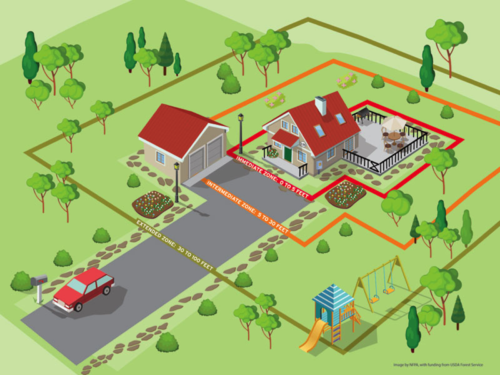
The Home Ignition Zone is broken down into three zones. The National Fire Protection Association (NFPA) states that Zone 1 (called the immediate zone, up to 5 ft. around the home) should be a non-combustible area and that it is the most important zone in which to take steps to reduce the home’s vulnerability. Homeowners should clean any debris from the home, repair any broken or missing roof tiles, windows, or screens, remove plants containing resins, oils, or waxes away from wall exteriors, use rocks instead of mulch for landscaping, remove any leaves or pine needles close to the home, and move firewood away from the home. Headwaters Economics suggests that using landscaping fabric can reduce the growth of weeds, minimizing the maintenance required by the homeowner. A biodegradable alternative to landscaping fabric (that also might emit less greenhouse gas if burned by wildfire) is to put down multiple layers of newspaper or cardboard underneath rocks or mulch, although they’ll need to be replaced every so often.
Although removing plants will reduce a home’s exposure to long term radiant heat or flame contact, less-combustible/fire-resistant plants do exist and there are also many benefits to including a rich plant life as part of your landscaping. Plants absorb carbon dioxide, producing oxygen in the air and, importantly, storing carbon in the soil. The process of storing carbon, called carbon sequestration, on a large scale can help reduce the effects of climate change. Choosing to include rich plantlife as part of your landscaping could contribute to reducing the effects of climate change — the reason why wildfires have become so widespread and dangerous in recent years. Furthermore, including plants in your landscaping can help rebuild organic matter lost in areas affected by fires and the storing of carbon by plants improves soil water retention. Soil with high water retention will not burn as easily.
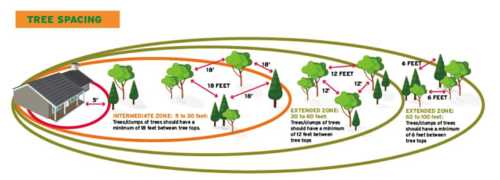
The benefits of including rich plant life as part of your home’s landscaping must be balanced with fire resilience considerations. Using less-combustible plants in Zones 2 and 3, maintaining vegetation, and spacing trees and shrubs in Zones 2 and 3 with fire protection in mind can reduce fire risk (see picture below). Less-combustible plants are those with high moisture content, high salt content and low volatile oil in their leaves. Typically, plants with broad, fleshy leaves and those with dense foliage, rather than open, airy crowns, are preferable. Maintaining a well-kept area, such as removing all ground litter and debris, removing dead plant/vegetative debris, cutting lawns and grasses to 4 inches (recommended by the NFPA), and pruning trees and shrubs will reduce the risk of a fire spreading to the home. The type of plants a homeowner includes in their landscaping will depend on individual fire risk, features of the home and yard, and preferences.
Additionally, using metal or hardwood for fencing or building concrete barriers between buildings on property and reduce the risk of fire spreading to the home.
2. Use fire resistant/non-combustible materials for roof and seal home around roof.
The roof is arguably the most vulnerable part of the home due to its large surface area. Plugging gaps between the roof and the home (in the eaves) and using non-combustible ember guards reduces risk of embers entering the home and increases energy efficiency. Using Class A fire-rated materials such as asphalt fiberglass composition, concrete, metal, or clay for roofing material is recommended to comply with codes from the National Fire Protection Association and the International Wildland-Urban Interface Codes. And while you’re changing up your roofing material, consider making your roof white which will cool your home and improve energy efficiency.
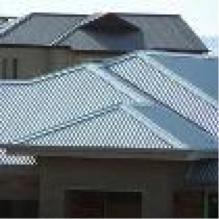
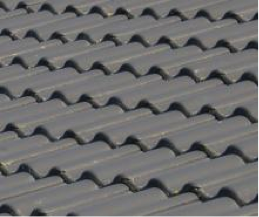
White Rooftops; Images from Green Cross Australia, Build It Back Green Guide.
3. Use fire resistant / non-combustible materials for deck and build deck area with fire resilience in mind.
Clean out vegetation from underneath the deck to create a non-combustible area underneath. This reduces the chance of fire spreading to your deck. Consider building your deck with larger spaces in between planks and using less-combustible material such as composite boards, fire-retardant-treated wood and other ignition-resistant material. Depending on how the wood is sourced, wood is the most environmentally friendly material. Usually, though, in order to make wood fire-resistant it must be treated with chemicals, making it less environmentally friendly. There are some companies that manufacture composite boards using recycled plastic material, such as Trex and Fiberon. And Fiberon states that it was named an Eco-Leader by Green Builder magazine in 2015 because it uses locally sourced recyclable material, uses bi-coastal manufacturing to reduce its carbon footprint, and does not use chemicals in its products. But these composite deck materials can never be recycled themselves. The best option would be to reuse these decking materials but there are no established programs (from my research) to help consumers do that.
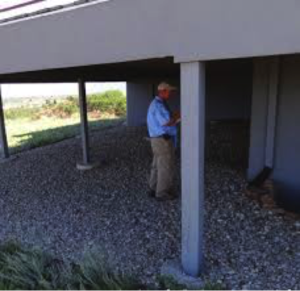
Non-combustible area underneath deck; Image from NFPA Wildfire Research Fact Sheets, originally from Insurance Institute for Business & Home Safety
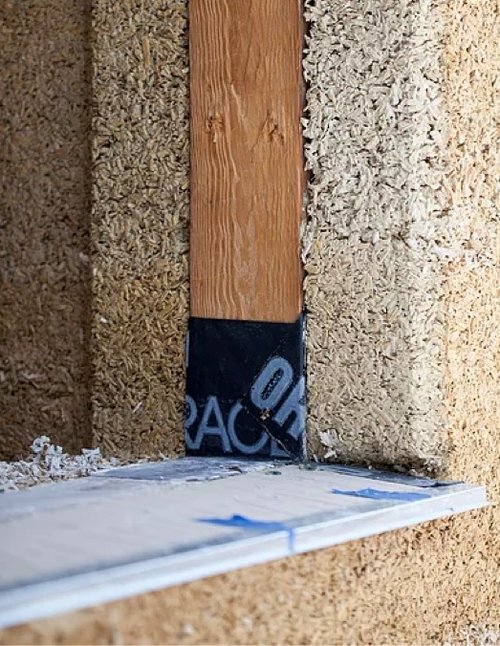
4. Use fire-resistant / non-combustible materials for building materials, siding, insulation, windows, and doors and seal doors and windows.
Tempered glass, dual pane (multi-layered) glass, and glass blocks for windows is recommended to comply with codes from the National Fire Protection Association, the International Wildland-Urban Interface Codes, as well as the California Building Code Chapter 7. More resistant hardwoods are the most environmentally friendly material for window shutters and frame, compared to metal and, especially, metal reinforced PVC-U, but might not be as fire resistant. There also exist wildfire resistant doors and fiber-cement siding which is fire resistant.
One environmentally friendly building material that is also very fire resistant (depending on density consistency and thickness) is “hempcrete” – which is the woody pulp of hemp combined with lime and water to create a thick material that can be used for insulation, over fiberglass insulation, and sometimes as interior or exterior walls. Companies that make and build structures using hempcrete include Hempitecture and Green Built.
Sealing areas around windows and doors will help in fire resiliency and increase your home’s energy efficiency.




